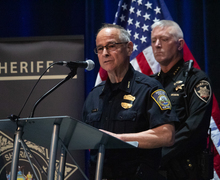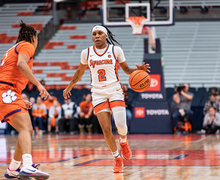Half a century later, Syracuse Nationals remembered as tough, elite team that provided city with a pulse
Graphic illustration by Ankur Patankar | Presentation Director
Life is timing.
Those are the wise words of Dolph Schayes.
Make one decision, and it could lead down one path. Make another, and the course of history changes.
Schayes almost joined the New York Knicks in 1948. Had he taken that path, who knows what would have become of the Syracuse Nationals. But he chose to play for Syracuse, where he would become a future Hall of Famer and the face of the upstart Nats.
“The people would come out,” Schayes said, “and the fact that ‘Little Syracuse is playing Boston, Syracuse is playing New York?’ The fans would go nuts when we beat them. And we won most of the time.”
The 2012-13 season, which started this week, marks the 50th anniversary of the Nationals’ final season in Syracuse. The Nats held court in Syracuse from 1946 through the 1962-63 season before moving to Philadelphia to become the 76ers.
The Nats had quite the run in Syracuse. But times were different then, on the court and in the city.
South Salina Street downtown resembled Fifth Avenue in New York City in the 1950s. If a member of the Syracuse Nationals walked down that street, everybody knew him.
“You were like a rock star,” Schayes said. “So you were a big shot.”
***
His name was “the strangler.” Who was he? One fan, maybe two?
He would go to Nationals games and attack opposing players. He attacked a referee one time. And then there was the time the referee Sid Borgia attacked a fan who was mouthing off, punching them courtside at the War Memorial.
“Syracuse was a rough, rough spot for opposing players and coaches,” said David Ramsey, who authored the book “Nats,” a history of basketball in Syracuse.
It was a tough team, period.
In a 1954 playoff game against the Boston Celtics in the Boston Garden, there was a full-fledged riot on the court. Paul Seymour, the Nats captain at the time, became involved, and a Boston police officer grabbed him out of the pile by the nose. His nose was never fully straight again.
Part of that scrappy mentality came from their longtime coach Al Cervi.
Cervi was called “the digger,” because his teams were built on hustle and drive.
“Of course that’s very trite, that’s strictly a sports term,” Schayes said. “But it was true. If we came into the third, fourth quarter behind 10, we knew we could win the game by just digging, outhustling the other team.
“In a way we caught the feeling of Syracuse. At that time it was a blue-collar town. And we were like the brand of Syracuse.”
***
Syracuse developed into a perennial power and won its lone NBA Championship in 1954-55.
It was also the first year of the shot clock. The Nationals boasted the likes of Schayes, Seymour, Earl Lloyd and Johnny Kerr. The team won the Eastern Division and beat the Celtics and Pistons on its way to the title.
The Pistons resided in Fort Wayne, Ind., at the time. The championship series featured places that were essentially towns — one in the center of New York state, and one in the Northeast corner of Indiana.
“Of course the publicity was nothing,” Schayes said. “Syracuse and Fort Wayne were the two smallest markets in the league. So if you went to The New York Times or The Philadelphia Inquirer or Chicago, you might get a paragraph on the sports page. And there was no television.
“Today they make hundreds of thousands (of dollars), plus they make bling and get rings; they go to Disney World.”
But Schayes has his ring, even though the tradition of rings being awarded to NBA champions began a few years after the Nats won their title.
Schayes visited Kerr, the Nationals’ center on that team, out in Chicago one time and noticed a ring he was wearing. It was an NBA Championship ring of 1955.
Schayes asked Kerr how he got the ring. Kerr said he went through the NBA and had it made by a company in Connecticut. So Schayes went out and bought himself one through the same place for around $8,000.
***
Schayes is the glue that held Syracuse together. He was the star of the show. And he has the memories to share.
“He has stories I haven’t heard yet,” his son, David Schayes, said. “He’s got the best stories.”
There’s one specific one Dolph remembers, though.
And even though he says he is forgetful, it’s hard to believe him since the stories he tells about that very forgetfulness are from 50 years ago.
On the court, Schayes had an intense focus and on game day, he was locked in.
“So I went to the game one night in Syracuse,” Schayes said. “And just before the game was ready, we were going out to the court, there was a knock on the door — it was a policeman.”
Schayes was so focused on the game he forgot to take his wife with him. But that intensity was a driving factor in his Hall of Fame career and the Nats’ success.
***
Eventually, Syracuse couldn’t keep up. Teams were moving west. Salaries were increasing. A small-market city like Syracuse didn’t have the power or money of a major market.
The team played in the Onondaga War Memorial, which only held about 6,000 people.
In the early 1960s, the NBA wanted to move two teams to the West Coast — to San Francisco and Los Angeles. Bob Short, the owner of the then-Minneapolis Lakers, wanted to go to the West and went to Danny Biasone, the owner of the Nats, asking him to move his franchise, too.
He told Biasone he’d give him the pick of San Francisco or LA, but Biasone was loyal to the fans and turned it down. Short ended up moving the Lakers to LA and sold them for $5 million one year later.
The Nationals’ last season in Syracuse ended in the first round of the playoffs. Interest seemed to be waning. In Syracuse, Schayes explained, there were not enough people to replace those fans that had stopped following the team.
The combination of fewer fans, increases in salaries and the NBA’s shift toward bigger cities contributed to the Nationals’ sale to Irv Kosloff for $500,000.
The team moved to Philadelphia and became the 76ers. And the Syracuse Nationals became a distant memory.
“It faded away, the element of Syracuse,” said Harvey Pollack, director of statistical information for the 76ers.
Pollack would know. He is the only person still working for the NBA since its inception in 1946.
“Fans of the Sixers today, some don’t even remember, aren’t old enough to know that there was a Syracuse franchise,” he said. “Because we’re talking about 50 years ago.”
***
Back to that ring. The one that didn’t exist at the time, the one Schayes had to seek out on his own.
“Wherever I go, whenever I wear it, I go on trips,” Schayes said. “People are astounded — ‘You played in the NBA? You won a championship?’ — it’s like your entrance to heaven. And people see that and they’re really impressed.”
It’s a tangible memory of the good times in Syracuse. It seems so far away now, but the city of Syracuse and the Nationals had quite the pulse back in the day.
And Schayes embodied it.
“Dolph Schayes, we always say that if he played today, with the three-point field goal, he would lead the league in scoring,” Pollack said. “I remember he was hurt one year. He had a fractured arm. And he played. He was what you call a dedicated player. He’s the most dominant player in Syracuse history.”
Multiple generations have grown since the final season of Syracuse Nationals basketball half a century ago. The NBA has expanded into a giant in the sports world. A team like Syracuse would never exist today.
But that, to Schayes, was what makes Syracuse and the Nationals stand out from other franchises in basketball history.
“The fans that we had were very loyal,” Schayes said. “And they really loved the team because it made them feel big-league. We were David versus Goliath.”
Published on October 31, 2012 at 2:56 am
Contact Rachel: [email protected]




